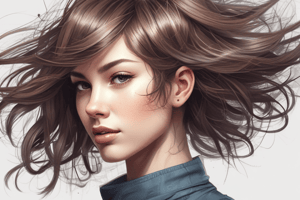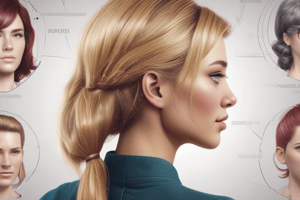Podcast
Questions and Answers
What is the definition of an angle in haircutting?
What is the definition of an angle in haircutting?
- The area of the head between the apex and back of the parietal ridge
- Space between two lines or surfaces that intersect at a given point (correct)
- The outermost perimeter along the face
- Technique using diagonal lines by cutting hair ends
What is the apex?
What is the apex?
Highest point on the top of the head
What is a bang (fringe)?
What is a bang (fringe)?
Triangular section that begins at the apex and ends at the front corners
What does beveling refer to in haircutting?
What does beveling refer to in haircutting?
What is a blunt haircut?
What is a blunt haircut?
What is carving?
What is carving?
Define clipper-over-comb.
Define clipper-over-comb.
What is cross-checking?
What is cross-checking?
What is the crown of the head?
What is the crown of the head?
What is a cutting line?
What is a cutting line?
Define distribution in haircutting.
Define distribution in haircutting.
What is elevation in haircutting?
What is elevation in haircutting?
What are the four corners in haircutting?
What are the four corners in haircutting?
What is free-hand notching?
What is free-hand notching?
What does free-hand slicing do?
What does free-hand slicing do?
Define graduated haircut.
Define graduated haircut.
What is graduation in haircutting?
What is graduation in haircutting?
What is a growth pattern in haircutting?
What is a growth pattern in haircutting?
What is a guideline in haircutting?
What is a guideline in haircutting?
Define hairline.
Define hairline.
What is the head form?
What is the head form?
What is meant by interior in haircutting?
What is meant by interior in haircutting?
What is an interior guideline?
What is an interior guideline?
What is a layered haircut?
What is a layered haircut?
What are layers in haircutting?
What are layers in haircutting?
What is a line in haircutting?
What is a line in haircutting?
What is a long-layered haircut?
What is a long-layered haircut?
What is the nape?
What is the nape?
What does notching refer to?
What does notching refer to?
What is over-direction?
What is over-direction?
What is palm-to-palm cutting?
What is palm-to-palm cutting?
What is the parietal ridge?
What is the parietal ridge?
What does parting mean?
What does parting mean?
What is the perimeter in a hairstyle?
What is the perimeter in a hairstyle?
What is point cutting?
What is point cutting?
Define razor-over-comb.
Define razor-over-comb.
What is razor rotation?
What is razor rotation?
What are reference points in haircutting?
What are reference points in haircutting?
What are sections in haircutting?
What are sections in haircutting?
What is scissor-over-comb?
What is scissor-over-comb?
What is slicing in haircutting?
What is slicing in haircutting?
What is slide cutting?
What is slide cutting?
What is slithering (effilating)?
What is slithering (effilating)?
What is a stationary guideline?
What is a stationary guideline?
What are subsections in haircutting?
What are subsections in haircutting?
What are tapers in haircutting?
What are tapers in haircutting?
Define tension in haircutting.
Define tension in haircutting.
What does texturizing do?
What does texturizing do?
What is a traveling guideline?
What is a traveling guideline?
What are uniform layers?
What are uniform layers?
What is a weight line?
What is a weight line?
Flashcards are hidden until you start studying
Study Notes
Haircutting Terms and Techniques
- Angle: Measurement of the space between intersecting lines or surfaces.
- Apex: Highest point on the head, used as a reference in shaping haircuts.
- Bang (Fringe): Triangular section of hair starting at the apex and ending at the front corners, framing the face.
- Beveling: Cutting technique utilizing diagonal lines for a subtle length increase.
- Blunt Haircut: A uniform haircut where all hair is cut to a single length, creating a weight line.
- Carving: A technique involving the shears placed against the scalp, cutting while manipulating blade movement.
- Clipper-Over-Comb: Clipper technique moving side to side instead of through the hair length, for shorter styles.
- Cross-Checking: Checking precision by parting the hair opposite to the original cut.
- Crown: Area located between the apex and back of the parietal ridge, important for hair fall.
- Cutting Line: The angle of fingers during a haircut which defines the cut's line, also known as finger angle.
Hair Characteristics and Cutting Methods
- Distribution: Refers to how hair is moved across the head during cutting.
- Elevation: The angle at which hair is lifted while cutting; can also be referred to as projection.
- Four Corners: Key points indicating transitions in the shape of the head, impacting haircut design.
- Free-Hand Notching: Cutting technique that randomly snips pieces of hair to create texture.
- Free-Hand Slicing: Allows hair to move more freely by releasing weight using slicing cuts.
- Graduated Haircut: Haircut producing a wedge shape, achieved through tension with low to medium elevation.
- Graduation: Created by lifting hair above a zero-degree angle, producing a layered effect.
- Growth Pattern: The natural direction hair grows from the scalp, essential for achieving a natural look.
Guiding Principles in Haircutting
- Guideline: A reference section defining the desired length of the haircut, vital for consistency.
- Hairline: The outermost perimeter of hair growth around the face and neck.
- Head Form: The shape of the head which influences how hair naturally drapes.
- Interior: Refers to the inside part of a haircut, affecting volume and movement.
- Interior Guideline: Guideline located within the haircut rather than the perimeter.
- Layered Haircut: Achieved by cutting hair at elevated angles, introducing texture and volume.
- Layers: Provides movement and volume while removing excess weight from the hair.
- Line: A continuous mark serving as a guide in haircutting, can be straight, curved, or angled.
Specific Haircutting Techniques
- Long-Layered Haircut: Haircut at a 180-degree angle, yielding shorter layers on top and longer layers towards the perimeter.
- Nape: Area at the back of the neck beneath the occipital bone, often styled or cut with precision.
- Notching: Technique creating a chunkier texture effect by cutting tips of the hair.
- Over-Direction: Combing away from the natural fall, used to achieve varied lengths.
- Palm-to-Palm: Cutting position where palms face each other, promoting control and symmetry.
Haircut Structure and Techniques
- Parietal Ridge: The widest area on the head, from temples to crown, crucial for shaping hairstyles.
- Part/Parting: Line dividing hair into sections for more manageable cutting.
- Perimeter: The outer boundary of a hairstyle, defining its shape.
- Point Cutting: Technique using the shears’ tips to create texture by cutting "points" into hair ends.
- Razor-Over-Comb: Texturizing method combining a comb and razor for softer edges.
Advanced Techniques and Guidelines
- Razor Rotation: Similar to razor-over-comb but involves circular motions for subtle blending.
- Reference Points: Markers on the head helping in understanding head shape and hair behavior.
- Sections: Dividing hair into uniform areas facilitates control during cutting.
- Scissor-Over-Comb: Technique where scissors remove hair lengths while the comb holds hair in place.
- Slicing: Method that thins hair while adding movement; involves partially closed shears.
Finishing Techniques
- Slide Cutting: Thinning method where fingers and shears glide along hair edges to adjust length.
- Slithering (Effilating): Thinning technique using a sliding motion of shears to create graduated lengths.
- Stationary Guideline: A fixed reference point during cutting, ensuring consistency in length.
- Subsections: Smaller divisions of hair used during a haircut for better control.
- Tapers: Haircutting effect creating a smooth transition from short to longer lengths.
- Tension: Pressure applied while holding and combing hair, impacting the haircut outcome.
- Texturizing: Removing bulk through specific techniques while maintaining length for a balanced look.
- Traveling Guideline: Moves with the haircutting progress, beneficial in layering or graduation.
- Uniform Layers: Hair is elevated to 90 degrees and cut at the same length, resulting in balanced layers.
- Weight Line: Visual line in a haircut where hair ends collectively hang, defining shape and style.
Studying That Suits You
Use AI to generate personalized quizzes and flashcards to suit your learning preferences.





